Differential Presence of Microplastics and Mesoplastics in Coral Reef and Mangrove Fishes in Isla Grande, Colombia
Abstract
:1. Introduction
2. Materials and Methods
2.1. Study Area and Sample Collection
2.2. Organic Digestion with Hydrogen Peroxide
2.3. Observation, Identification, and Validation of Microplastics and Mesoplastics
2.4. Quality Control of Experiments
2.5. Statistical Analysis
3. Results
3.1. Abundance of Microplastics and Mesoplastics
3.2. Plastics in the Stomach and Intestine of Coral Reef and Mangrove Species
3.3. Accumulation of Plastics with Sex, Size, and Trophic Guild
3.4. Most Common Polymers Present in Plastics
4. Discussion
4.1. Abundance of Microplastics and Mesoplastics in Mangrove and Coral Reef and Their Accumulation with Sex, Size, and Trophic Guild
4.2. Plastics in the Stomach and Intestine of Coral Reef and Mangrove Species
4.3. Most Common Polymers Present in Plastics
5. Conclusions
Author Contributions
Funding
Institutional Review Board Statement
Informed Consent Statement
Data Availability Statement
Acknowledgments
Conflicts of Interest
References
- Derraik, J. The pollution of the marine environment by plastic debris: A review. Mar. Pollut. Bull. 2002, 44, 842–852. [Google Scholar] [CrossRef]
- Geyer, R.; Jambeck, J.R.; Law, K.L. Production, use, and fate of all plastics ever made. Sci. Adv. 2017, 3, 25–29. [Google Scholar] [CrossRef] [PubMed]
- Rochman, C.M.; Tahir, A.; Williams, S.L.; Baxa, D.V.; Lam, R.; Miller, J.T.; Foo-Ching, T.; Werorilangi, S.; Teh, S.J. Anthropogenic debris in seafood: Plastic debris and fibers from textiles in fish and bivalves sold for human consumption. Sci. Rep. 2015, 5, 14340. [Google Scholar] [CrossRef] [PubMed]
- Ivar do Sul Juliana, C.M. Marine debris review for Latin America and the wider Caribbean Region. From the 1970s until now, and where do we go from here? Mar. Pollut. Bull. 2007, 54, 1087–1104. [Google Scholar] [CrossRef]
- Boerger, C.M.; Lattin, G.L.; Moore, S.L.; Moore, C.J. Plastic ingestion by planktivorous fishes in the North Pacific Central Gyre. Mar. Pollut. Bull. 2010, 60, 2275–2278. [Google Scholar] [CrossRef]
- Jabeen, K.; Su, L.; Li, J.; Yang, D.; Tong, C.; Mu, J.; Shi, H. Microplastics and mesoplastics in fish from coastal and fresh waters of China. Environ. Pollut 2017, 221, 141–149. [Google Scholar] [CrossRef]
- Blair, C.; Quinn, B. Microplastic Pollutants, 1st ed.; Elservier Limited: London, UK, 2016. [Google Scholar]
- Andrade, M.C.; Winemiller, K.O.; Barbosa, P.S.; Fortunati, A.; Chelazzi, D.; Cincinelli, A.; Giarrizzo, T. First account of plastic pollution impacting freshwater fishes in the Amazon: Ingestion of plastic debris by piranhas and other serrasalmids with diverse feeding habits. Environ. Pollut. 2019, 244, 766–773. [Google Scholar] [CrossRef]
- Dehaut, A.; Hermabessiere, L.; Duflos, G. Current frontiers and recommendations for the study of microplastics in seafood. Trends Anal. Chem. 2019, 116, 346–359. [Google Scholar] [CrossRef]
- Moore, C.J. Synthetic polymers in the marine environment: A rapidly increasing, long-term threat. Environ. Res. 2008, 108, 131–139. [Google Scholar] [CrossRef]
- Wright, S.L.; Thompson, R.C.; Galloway, T.S. The physical impacts of microplastics on marine organisms: A review. Environ. Pollut. 2013, 178, 483–492. [Google Scholar] [CrossRef]
- Niaounakis, M. The Problem of Marine Plastic Debris. In Management of Marine Plastic Debris; William Andrew Publishing: Oxford, UK, 2017; pp. 1–55. [Google Scholar]
- Possatto, F.E.; Barletta, M.; Costa, M.F.; Ivar do Sul, J.A.; Dantas, D.V. Plastic debris ingestion by marine catfish: An unexpected fisheries impact. Mar. Pollut. Bull. 2011, 62, 1098–1102. [Google Scholar] [CrossRef]
- Renzi, M.; Specchiulli, A.; Blašković, A.; Manzo, C.; Mancinelli, G.; Cilenti, L. Marine litter in stomach content of small pelagic fishes from the Adriatic Sea: Sardines (Sardina pilchardus) and anchovies (Engraulis encrasicolus). Environ. Sci. Pollut. Res. 2019, 26, 2771–2781. [Google Scholar] [CrossRef]
- McGoran, A.R.; Cowie, P.R.; Clark, P.F.; McEvoy, J.P.; Morritt, D. Ingestion of plastic by fish: A comparison of Thames Estuary and Firth of Clyde populations. Mar. Pollut. Bull. 2018, 137, 12–23. [Google Scholar] [CrossRef]
- Cole, M.; Lindeque, P.; Fileman, E.; Halsband, C.; Galloway, T.S. The impact of polystyrene microplastics on feeding, function, and fecundity in the marine copepod Calanus helgolandicus. Environ. Sci. Technol. 2015, 49, 1130–1137. [Google Scholar] [CrossRef]
- Eriksen, M.; Lebreton, L.C.M.; Carson, H.S.; Thiel, M.; Moore, C.J.; Borerro, J.C.; Galgani, F.; Ryan, P.G.; Reisser, J. Plastic Pollution in the World’s Oceans: More than 5 trillion Plastic Pieces Weighing over 250,000 Tons Afloat at Sea. PLoS ONE 2014, 9, e111913. [Google Scholar]
- Azad, S.M.O.; Towatana, P.; Pradit, S.; Patricia, B.G.; Hue, H.T.T.; Jualaong, S. First evidence of existence of microplastics in stomach of some commercial fishes in the lower gulf of thailand. App. Ecol. Environ. Res. 2018, 16, 7345–7360. [Google Scholar] [CrossRef]
- Jeftic, L.; Sheavly, S.; Adler, E.; Meith, N. Marine Litter: A Global Challenge; UNEP Marine Litter Publications: Nairobi, Kenya, 2009; Volume 232. [Google Scholar]
- Garcés-Ordóñez, O.; Castillo-Olaya, V.A.; Granados-Briceño, A.F.; Blandón García, L.M.; Espinosa Díaz, L.F. Marine litter and microplastic pollution on mangrove soils of the Ciénaga Grande de Santa Marta, Colombian Caribbean. Mar. Pollut. Bull. 2019, 145, 455–462. [Google Scholar] [CrossRef]
- Mohamed Nor, N.H.; Obbard, J.P. Microplastics in Singapore’s coastal mangrove ecosystems. Mar. Pollut. Bull. 2014, 79, 278–283. [Google Scholar] [CrossRef]
- FAO. The World’s Mangroves 1980–2005; FAO Forestry Paper; FAO: Rome, Italy, 2007; Volume 153, p. 89. [Google Scholar]
- Barasarathi, J.; Agamuthu, P.; Emenike, C.U.; Fauziah, S.H. Microplastic abundance in selected mangrove forest in Malaysia. In Proceedings of the ASEAN Conference on Science and Technology, Bogor, Indonesia, 18–20 August 2014. [Google Scholar]
- Hall, N.M.; Berry, K.L.E.; Rintoul, L.; Hoogenboom, M.O. Microplastic ingestion by scleractinian corals. Mar. Biol. 2015, 162, 725–732. [Google Scholar] [CrossRef]
- Valdelamar-Villegas, J.C.; Olivero-Verbel, J.; Pareja-Hernández, S.E.; Ropero-Vega, J. Avances sonre la contaminación por mercurio de moluscos Donax denticulatus en el caribe colombiano. In Proceedings of the II Seminario de Ciencias Ambientales Sue-Caribe & VII Seminario Internacional de Gestión Ambiental, Santa Marta, Colombia, 10–12 September 2014. [Google Scholar]
- Duran, C.A. Gobernanza en los Parques Nacionales Naturales Colombianos. Rev. De Estud. Soc. 2009, 32, 60–73. [Google Scholar]
- Pineda, I.; Martínez, L.A.; Bedoya, D.; Caparroso, P.; Rojas, J.A. Plan de Manejo Parque Nacional Natural Corales Del Rosario Y San Bernardo; UAESPNN Territorial Costa Caribe: Cartagena, Spain, 2006. [Google Scholar]
- Chasqui, L.; Polanco, A.; Acero, A.; Mejía-Falla, P.A.; Navia, A.; Zapata, L.A.; Caldas, J.P. Libro Rojo de Peces Marinos de Colombia; Serie de Publicaciones Generales de INVEMAR # 93; Instituto de Investigaciones Marinas y Costeras Invemar, Ministerio de Ambiente y Desarrollo Sostenibl: Santa Marta, Colombia, 2017; 552p. [Google Scholar]
- Froese, R.; Pauly, D. (Eds.) FishBase. 2011. Available online: www.fishbase.org (accessed on 30 July 2022).
- Duarte, L.O.; García, C.B. Diet of the Lane Snapper, Lutjanus synagris (Lutjanidae), in the Gulf of Salamanca, Colombia. Caribb. J. Sci. 1999, 35, 54–63. [Google Scholar]
- INVEMAR. Protocolo de Muestreo y Análisis de Microplásticos en Aguas Marinas Superficiales, Sedimentos de Playas y Tracto Digestive de Peces; MinAmbiente: Santa Marta, Colombia, 2017; 21p. [Google Scholar]
- Gómez Gaspar, A. Desarrollo gonadal y sexualidad de peces teleosteos. Saber 1995, 7, 7–17. [Google Scholar]
- Rojo-Bartolomé, I.; De Cerio, O.D.; Diez, G.; Cancio, I. Identification of sex and female’s reproductive stage in commercial fish species through the quantification of ribosomal transcripts in gonads. PLoS ONE 2016, 11, e0149711. [Google Scholar]
- Li, J.; Yang, D.; Li, L.; Jabeen, K.; Shi, H. Microplastics in commercial bivalves from China. Environ. Pollut. 2015, 207, 190–195. [Google Scholar] [CrossRef] [PubMed]
- Kühn, S.; van Werven, B.; van Oyen, A.; Meijboom, A.; Bravo Rebolledo, E.L.; van Franeker, J.A. The use of potassium hydroxide (KOH) solution as a suitable approach to isolate plastics ingested by marine organisms. Mar. Pollut. Bull. 2017, 115, 86–90. [Google Scholar] [CrossRef] [PubMed]
- Zar, J.H. Biostatistical Analysis, 5th ed.; Pearson Education: Chennai, India, 2013. [Google Scholar]
- Hair, J.F.; Black, W.C.; Babin, B.J.; Anderson, R.E.; Tatham, R.L. Multivariate Data Analysis; Prentice Hall: Bergen, NJ, USA, 1998; Volume 5, pp. 207–219. [Google Scholar]
- Vendel, A.L.; Bessa, F.; Alves, V.E.N.; Amorim, A.L.A.; Patrício, J.; Palma, A.R.T. Widespread microplastic ingestion by fish assemblages in tropical estuaries subjected to anthropogenic pressures. Mar. Pollut. Bull. 2017, 117, 448–455. [Google Scholar] [CrossRef] [PubMed]
- Calderón, E.; Hansen, P. Microplastics in the Digestive Tract of Fish from the Estuary Ciénaga Grande de Santa Marta, Colombia. Master’s Thesis, Roskilde University, Roskilde, Denmark, 2018. [Google Scholar]
- Lebreton, L.C.M.; Van Der Zwet, J.; Damsteeg, J.W.; Slat, B.; Andrady, A.; Reisser, J. River plastic emissions to the world’s oceans. Nat. Commun. 2017, 8, 15611. [Google Scholar] [CrossRef]
- Acosta-Coley, I.; Olivero-Verbel, J. Microplastic resin pellets on an urban tropical beach in Colombia. Environ. Monit. Assess 2015, 187, 435. [Google Scholar] [CrossRef]
- Hernández, F.A.C. Composición y Abundancia de Especies Ícticas Comerciales y en Estado de Amenaza Presentes en el Parque Nacional Natural Corales del Rosario, Caribe Colombiano; Jorge Tadeo Lozano University: Bogotá, Colombia, 2009. [Google Scholar]
- Davison, P.; Asch, R.G. Plastic ingestion by mesopelagic fishes in the North Pacific Subtropical Gyre. Mar. Ecol. Prog. Ser. 2011, 432, 173–180. [Google Scholar] [CrossRef]
- Jin-Eong, O. The ecology of mangrove conservation & management. Hydrobiologia 1995, 295, 343–351. [Google Scholar]
- Wieczorek, A.M.; Morrison, L.; Croot, P.L.; Allcock, A.L.; MacLoughlin, E.; Savard, O.; Doyle, T.K. Frequency of microplastics in mesopelagic fishes from the Northwest Atlantic. Front. Mar. Sci. 2018, 5, 39. [Google Scholar] [CrossRef]
- Karami, A.; Golieskardi, A.; Choo, C.K.; Larat, V.; Karbalaei, S.; Salamatinia, B. Microplastic and mesoplastic contamination in canned sardines and sprats. Sci. Total Environ. 2018, 612, 1380–1386. [Google Scholar] [CrossRef]
- Van Cauwenberghe, L.; Janssen, C.R. Microplastics in bivalves cultured for human consumption. Environ. Pollut. 2014, 193, 65–70. [Google Scholar] [CrossRef]
- Todd, P.A.; Ong, X.; Chou, L.M. Impacts of pollution on marine life in Southeast Asia. Biodivers. Conserv. 2010, 19, 1063–1082. [Google Scholar] [CrossRef]
- Carpenter, E.J.; Anderson, S.J.; Harvey, G.R.; Miklas, H.P.; Peck, B.B. Polystyrene spherules in coastal waters. Science 1972, 178, 749–750. [Google Scholar] [CrossRef]
- Horton, A.A.; Jürgens, M.D.; Lahive, E.; van Bodegom, P.M.; Vijver, M.G. The influence of exposure and physiology on microplastic ingestion by the freshwater fish Rutilus rutilus (roach) in the River Thames, UK. Environ. Pollut 2018, 236, 188–194. [Google Scholar] [CrossRef]
- Schückel, S.; Sell, A.F.; Kröncke, I.; Reiss, H. Diet overlaps among flatfish species in the southern North Sea. J. Fish Biol. 2012, 80, 2571–2594. [Google Scholar] [CrossRef]
- Foekema, E.M.; De Gruijter, C.; Mergia, M.T.; Van Franeker, J.A.; Murk, A.J.; Koelmans, A.A. Plastic in North Sea fish. Environ. Sci. Technol. 2013, 47, 8818–8824. [Google Scholar] [CrossRef]
- Tanaka, K.; Takada, H. Microplastic fragments and microbeads in digestive tracts of planktivorous fish from urban coastal waters. Sci. Rep. 2016, 6, 34351. [Google Scholar] [CrossRef]
- Chagnon, C.; Thiel, M.; Antunes, J.; Ferreira, J.L.; Sobral, P.; Ory, N.C. Plastic ingestion and trophic transfer between Easter Island flying fish (Cheilopogon rapanouiensis) and yellowfin tuna (Thunnus albacares) from Rapa Nui (Easter Island). Environ. Pollut. 2018, 243, 127–133. [Google Scholar] [CrossRef]
- Lambert, Y.; Dutil, J.D. Energetic consequences of reproduction in Atlantic cod (Gadus morhua) in relation to spawning level of somatic energy reserves. Can. J. Fish. Aquat. Sci. 2000, 57, 815–825. [Google Scholar] [CrossRef]
- Diana, J.S.; Mackay, W.C.; Ehrman, M. Movements and Habitat Preference of Northern Pike (Esox lucius) in Lac Ste. Anne, Alberta. Trans. Am. Fish. Soc. 1977, 106, 560–565. [Google Scholar] [CrossRef]
- Anastasopoulou, A.; Mytilineou, C.; Smith, C.J.; Papadopoulou, K.N. Plastic debris ingested by deep-water fish of the Ionian Sea (Eastern Mediterranean). Deep Sea Res. Part I Oceanogr Res. Pap. 2013, 74, 11–13. [Google Scholar] [CrossRef]
- Romeo, T.; Pietro, B.; Pedà, C.; Consoli, P.; Andaloro, F.; Fossi, M.C. First evidence of presence of plastic debris in stomach of large pelagic fish in the Mediterranean Sea. Mar. Pollut. Bull. 2015, 95, 358–361. [Google Scholar] [CrossRef]
- Rummel, C.D.; Löder, M.G.J.; Fricke, N.F.; Lang, T.; Griebeler, E.M.; Janke, M.; Gerdts, G. Plastic ingestion by pelagic and demersal fish from the North Sea and Baltic Sea. Mar. Pollut. Bull. 2016, 102, 134–141. [Google Scholar] [CrossRef]
- Courtene-Jones, W.; Quinn, B.; Gary, S.F.; Mogg, A.O.M.; Narayanaswamy, B.E. Microplastic pollution identified in deep-sea water and ingested by benthic invertebrates in the Rockall Trough, North Atlantic Ocean. Environ. Pollut. 2017, 231, 271–280. [Google Scholar] [CrossRef] [Green Version]
- Hipfner, J.M.; Galbraith, M.; Tucker, S.; Studholme, K.R.; Domalik, A.D.; Pearson, S.F.; Good, T.P.; Hodum, P. Two forage fishes as potential conduits for the vertical transfer of microfibres in Northeastern Pacific Ocean food webs. Environ. Pollut. 2018, 239, 215–222. [Google Scholar] [CrossRef]
- Koch, H.M.; Drexler, H.; Angerer, J. An estimation of the daily intake of di (2-ethylhexyl) phthalate (DEHP) and other phthalates in the general population. Int. J. Hyg. Environ. Health 2003, 206, 77–83. [Google Scholar] [CrossRef]
- Frias, J.P.G.L.; Sobral, P.; Ferreira, A.M. Organic pollutants in microplastics from two beaches of the Portuguese coast. Mar. Pollut. Bull. 2010, 60, 1988–1992. [Google Scholar] [CrossRef]
- Klein, E.; Lukes, V.; Cibulková, Z. On the energetics of phenol antioxidants activity. Pet. Coal 2005, 47, 33–39. [Google Scholar]
- Ogata, Y.; Takada, H.; Mizukawa, K.; Hirai, H.; Iwasa, S.; Endo, S.; Mato, Y.; Saha, M.; Okuda, K.; Nakashima, A.; et al. International pellet watch: Global monitoring of persistent organic pollutants (POPs) in coastal waters. 1. Initial phase data on PCBs, DDTs, and HCHs. Mar. Pollut. Bull. 2009, 58, 1437–1446. [Google Scholar] [CrossRef]
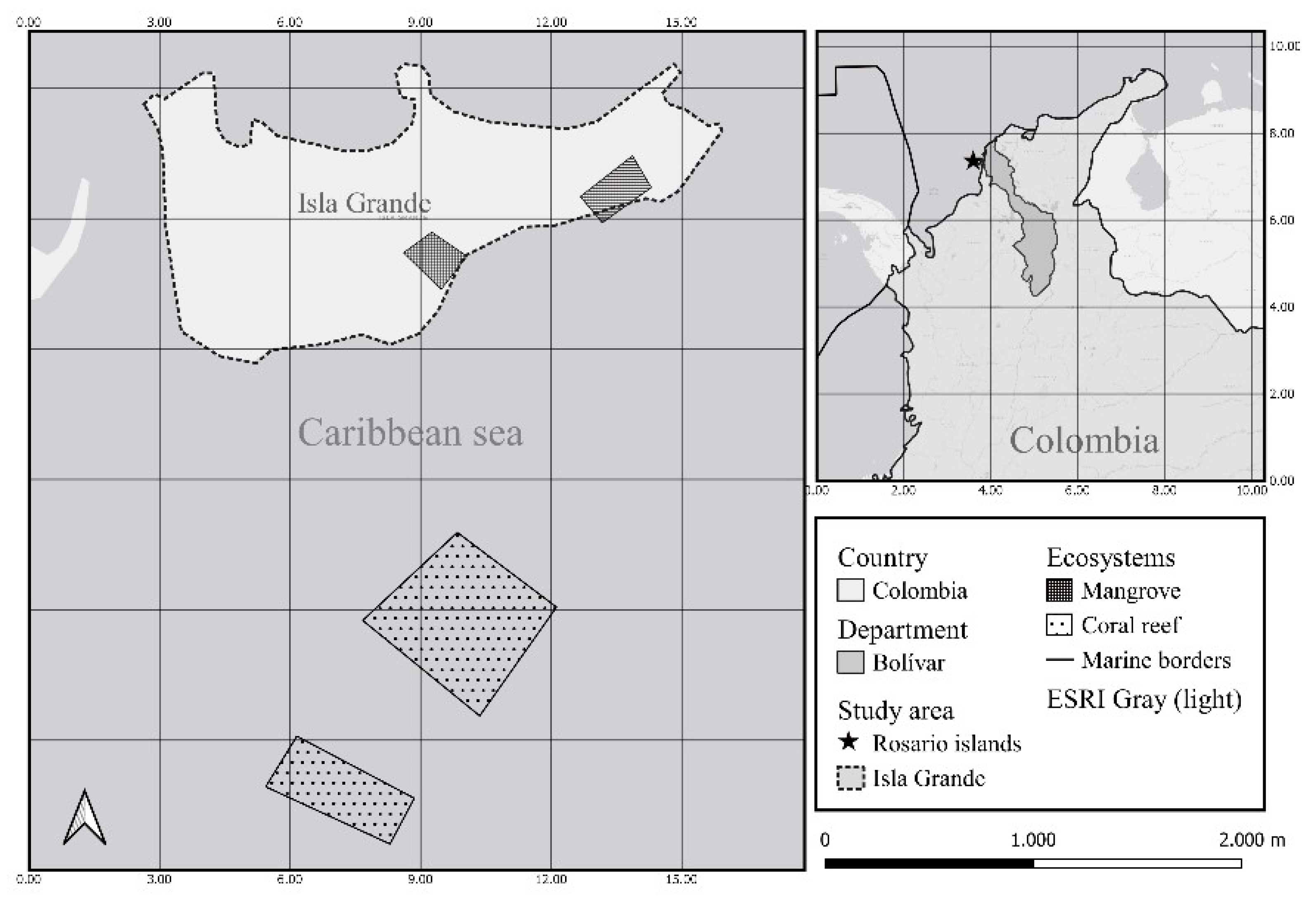

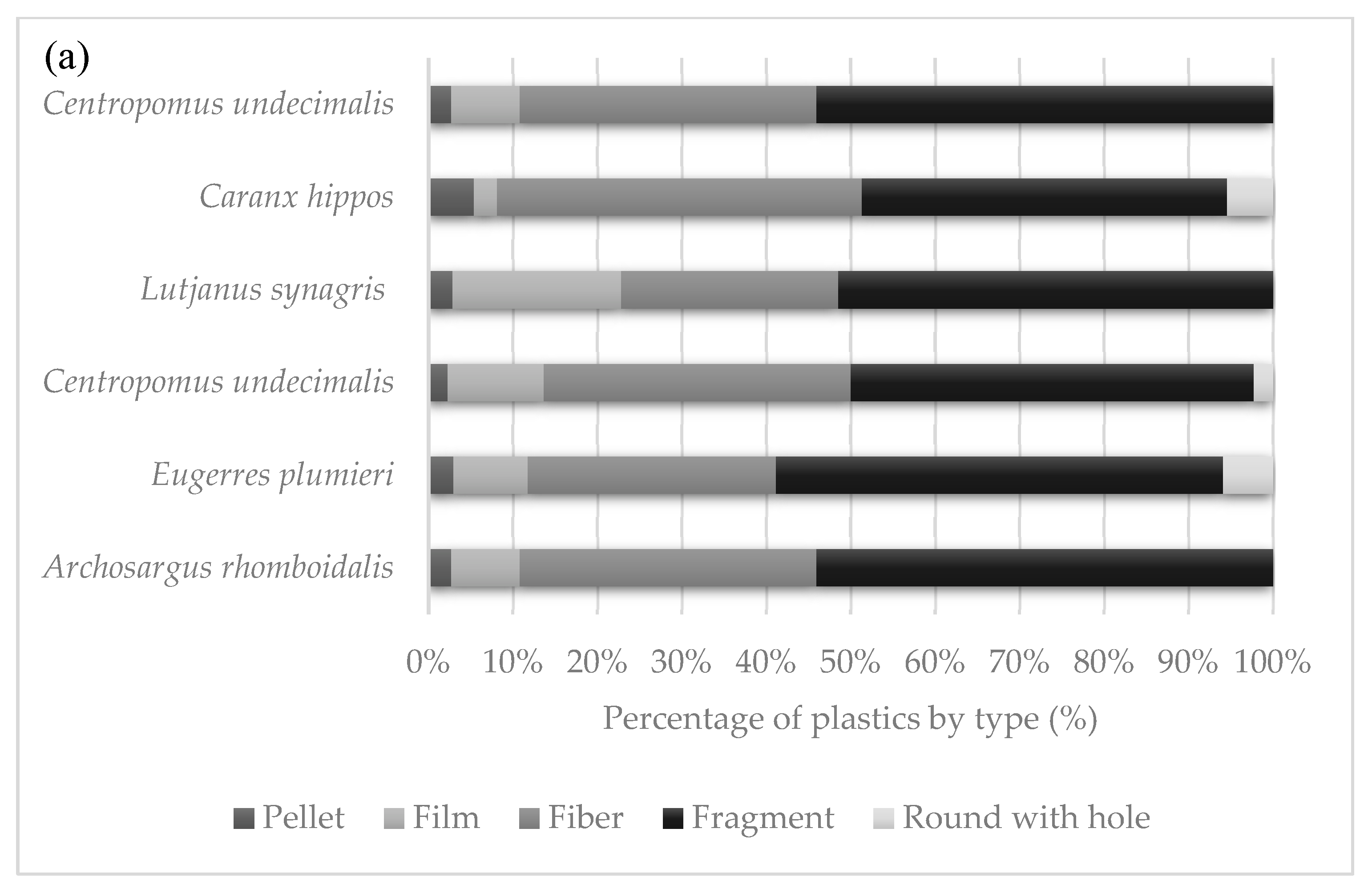

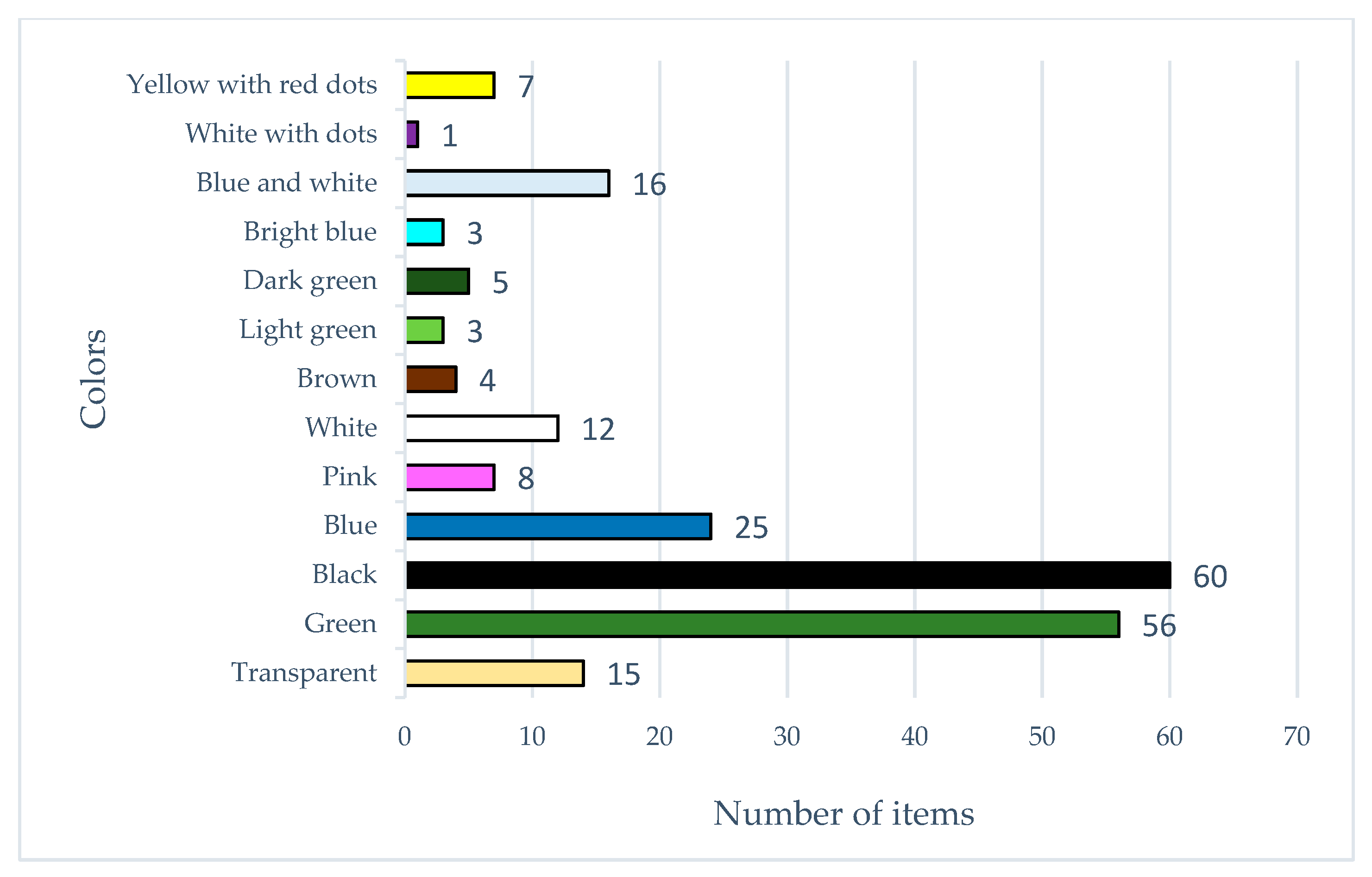
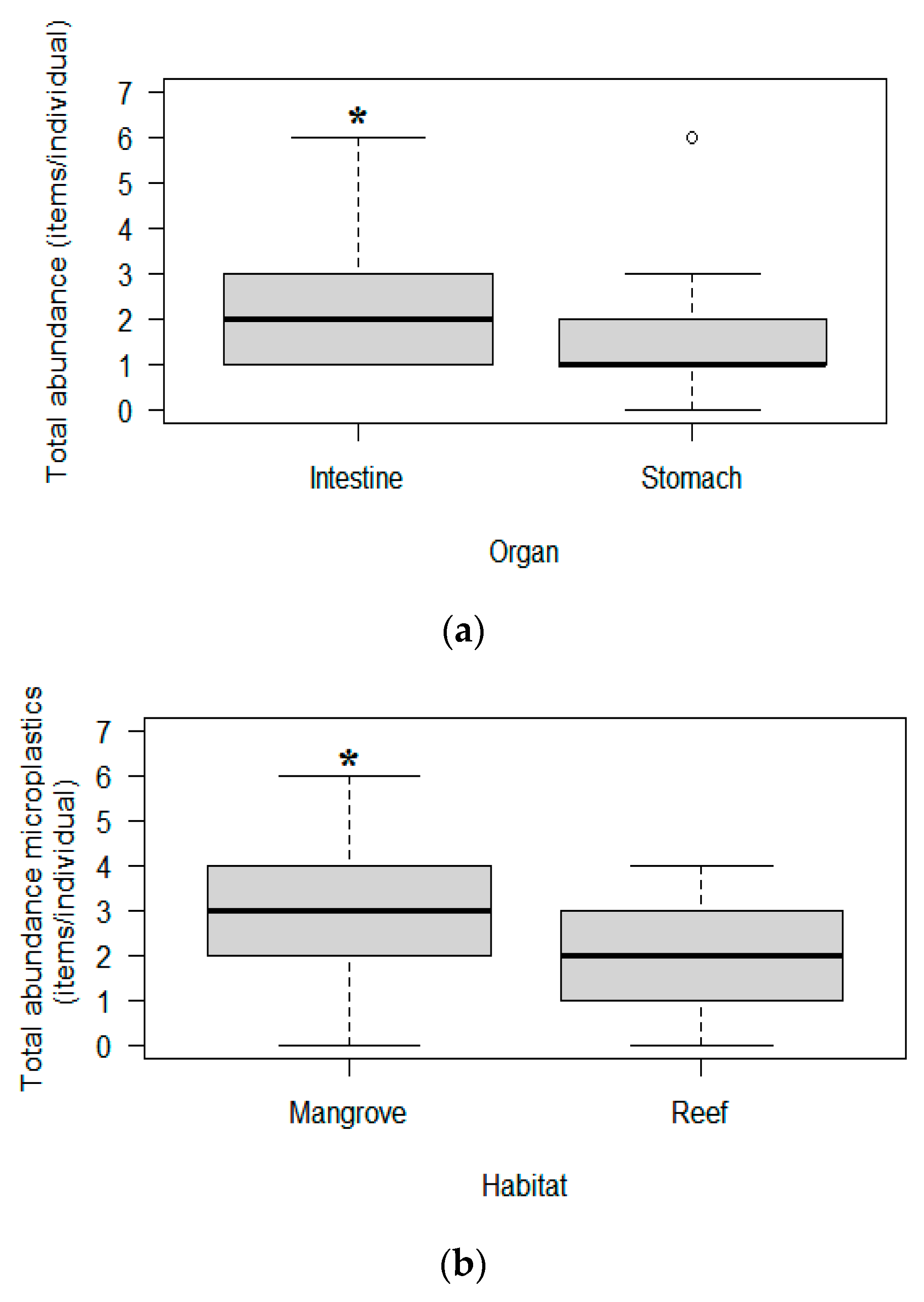
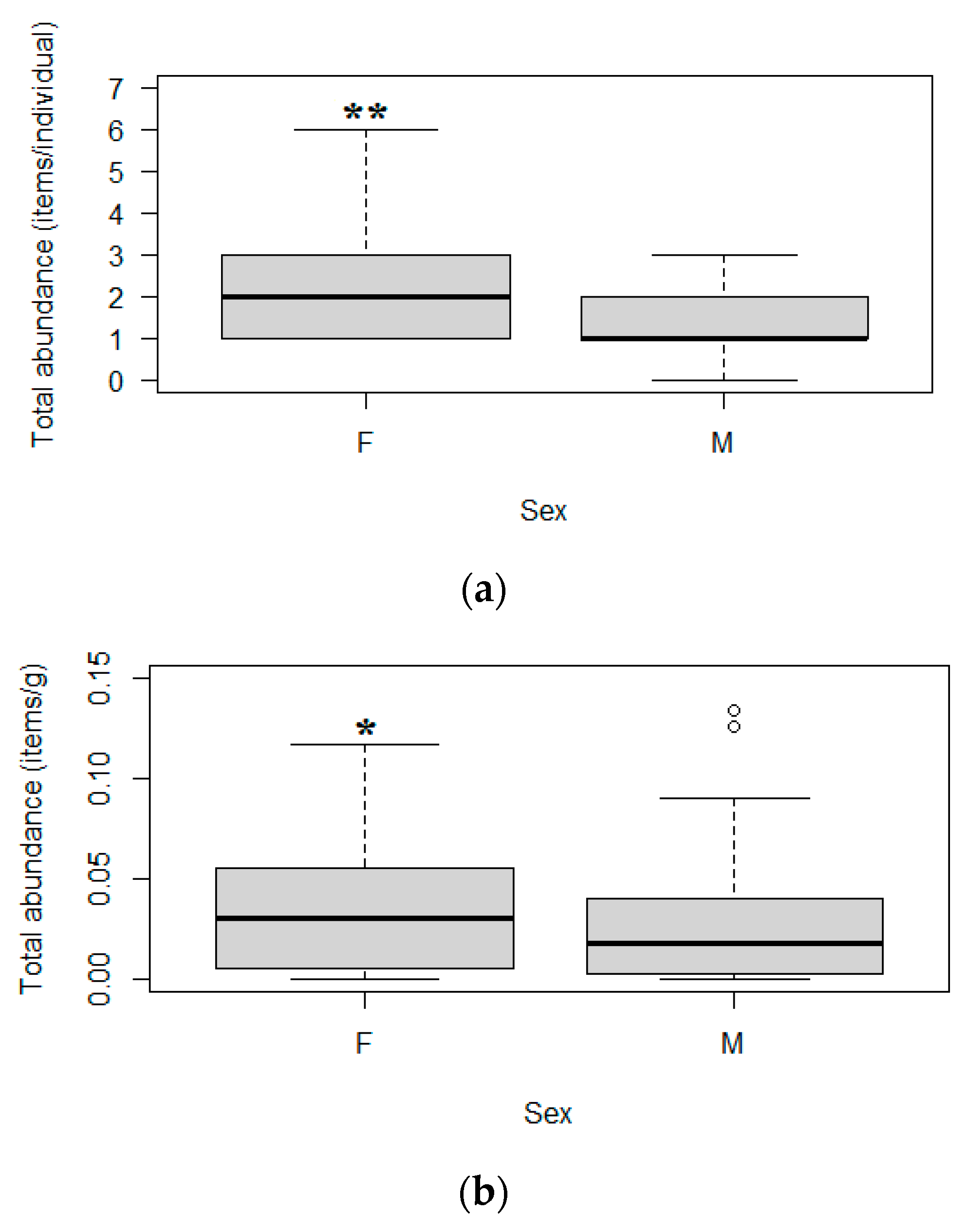
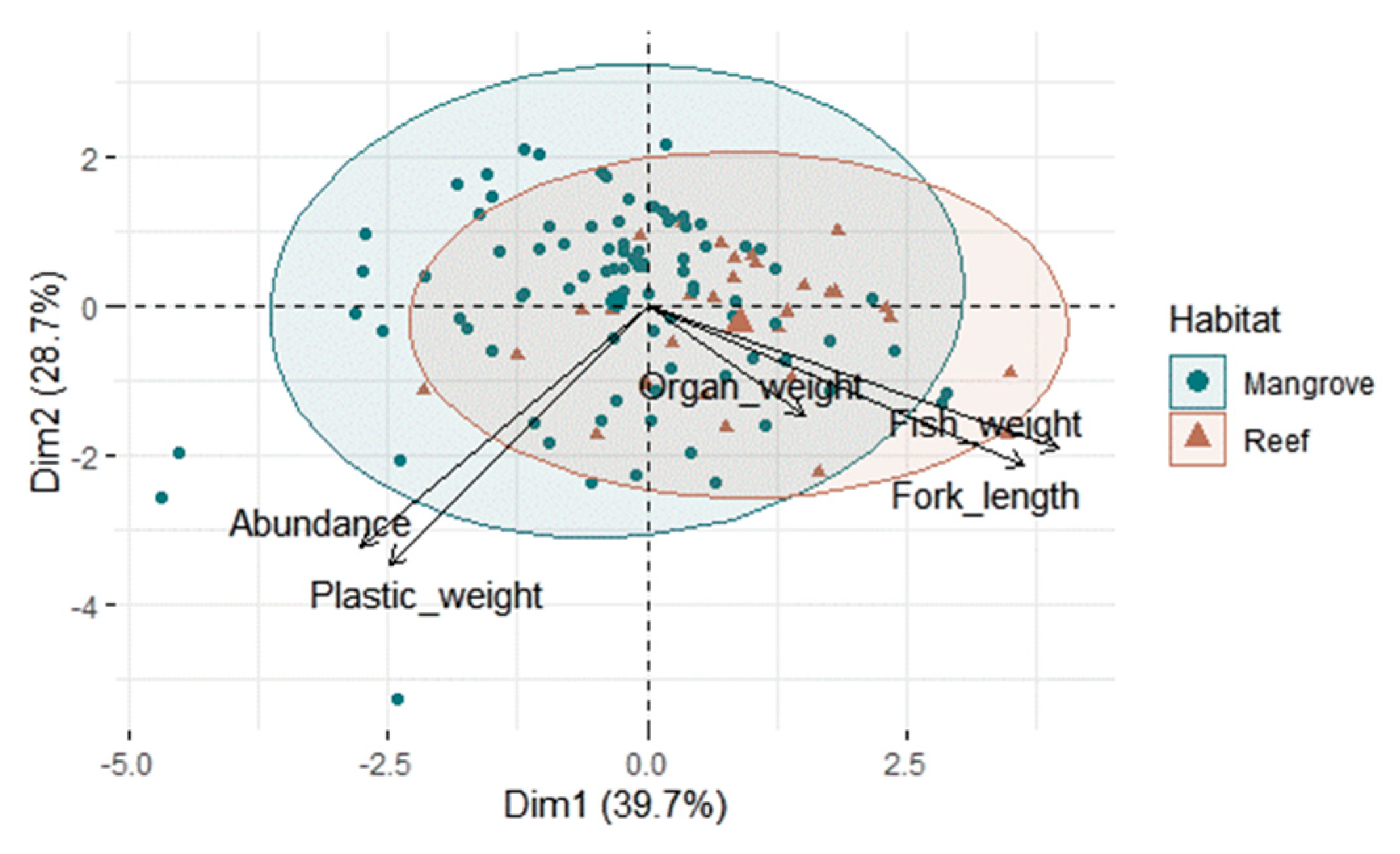
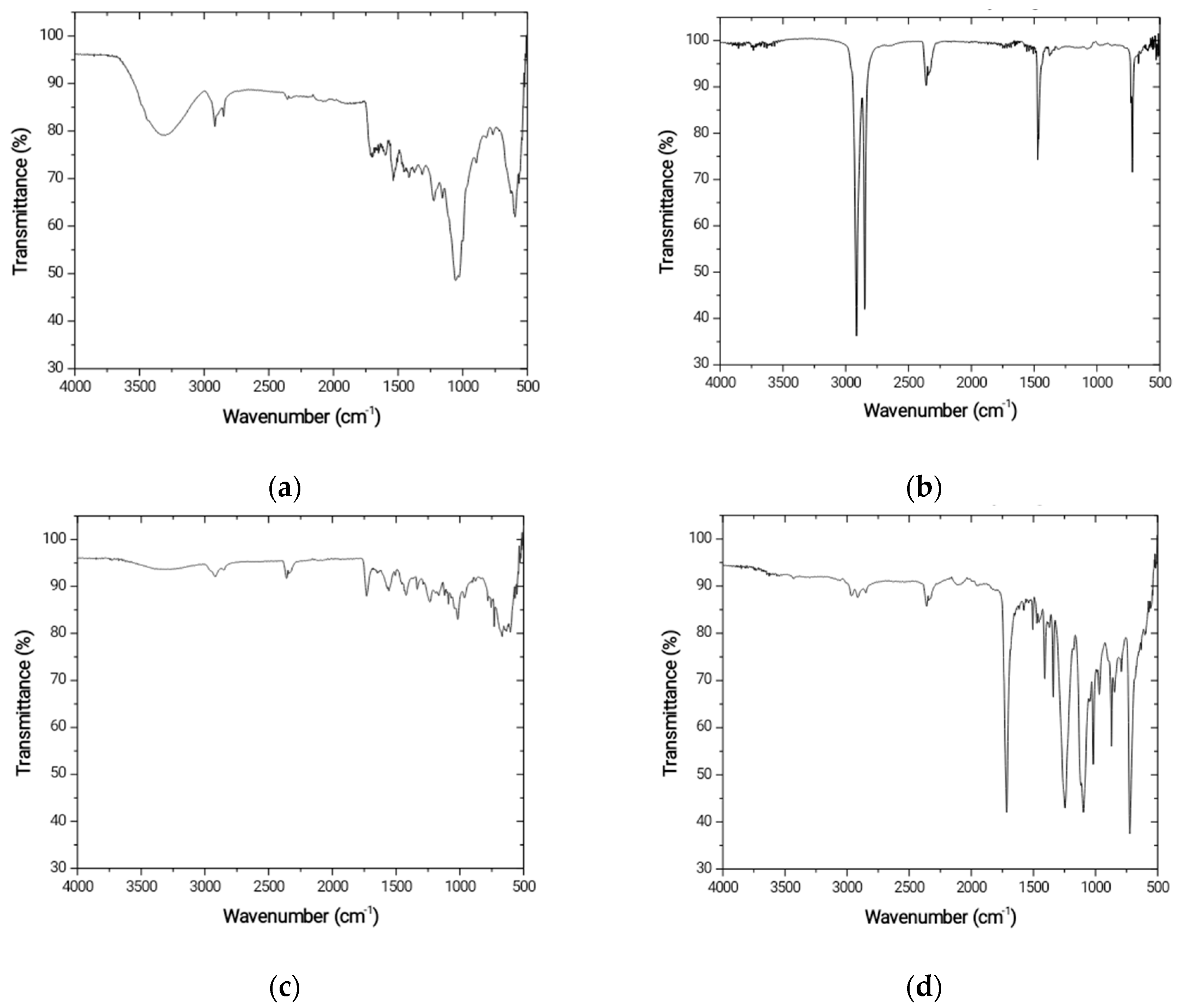
| Fish Species | Feeding Features | Weight (g) | Fork Length (cm) | Microplastics | Mesoplastics | ||
|---|---|---|---|---|---|---|---|
| items/g | items/individual | items/g | items/individual | ||||
| Coral reef | |||||||
| Caranx hippos Crevalle jack | Carnivore | 223.4 ± 37.0 | 20.5 ± 1.2 | 0.019 ± 0.02 | 0.9 ± 0.7 | 0.015 ± 0.02 | 1.05 ± 1.1 |
| Centropomus undecimalis Common snook | Carnivore | 198.6 ± 57.9 | 24.6 ± 3.1 | 0.015 ± 0.02 | 0.7 ± 0.6 | 0.014 ± 0.02 | 0.75 ± 0.8 |
| Lutjanus synagris Lane snapper | Carnivore | 181.7 ± 45.3 | 19.3 ± 2.1 | 0.020 ± 0.02 | 0.9 ± 0.9 | 0.019 ± 0.02 | 0.85 ± 1.3 |
| Mangrove | |||||||
| Archosargus rhomboidalis Western Atlantic seabream | Omnivore | 137.8 ± 43.0 | 15.3 ± 1.8 | 0.018 ± 0.02 | 0.9 ± 1.3 | 0.020 ± 0.02 | 1.0 ± 1.2 |
| Eugerres plumieri Striped mojarra | Omnivore | 110.1 ± 28.1 | 15.4 ± 1.3 | 0.016 ± 0.02 | 0.7 ± 0.7 | 0.022 ± 0.03 | 1.05 ± 1.1 |
| Centropomus undecimalis Common snook | Carnivore | 155.2 ± 37.8 | 22.8 ± 1.7 | 0.022 ± 0.02 | 1.0 ± 0.9 | 0.017 ± 0.02 | 1.20 ± 1.2 |
| Fish Species | Microplastics (%) | Mesoplastics (%) | Sizes (%) | np | |||||||||
|---|---|---|---|---|---|---|---|---|---|---|---|---|---|
| Pellets | Films | Fibers | Fragments | Rounds with Hole | Pellet | Films | Fibers | Fragments | Rounds with Hole | <5 mm | >5.1 mm | ||
| C. undecimalis | 3.4 | 6.9 | 27.6 | 24.1 | 0 | 0 | 10.3 | 3.4 | 24.1 | 0 | 62.1 | 38 | 30 |
| C. hippos | 5.4 | 0 | 37.8 | 29.7 | 5.4 | 0 | 2.7 | 5.4 | 13.5 | 0 | 78.4 | 22 | 36 |
| L. synagris | 0 | 11.4 | 17.1 | 28.6 | 0 | 2.9 | 8.6 | 8.6 | 22.9 | 0 | 57 | 42.9 | 34 |
| C. undecimalis | 2.3 | 11.4 | 27.3 | 38.6 | 2.3 | 0 | 0 | 9.1 | 9.1 | 0 | 81.8 | 18 | 44 |
| E. plumieri | 2.9 | 5.9 | 26.5 | 44.1 | 5.9 | 0 | 2.9 | 2.9 | 8.8 | 0 | 85.3 | 15 | 34 |
| A. rhomboidalis | 2.7 | 8.1 | 35.1 | 51.4 | 0 | 0 | 0 | 0 | 2.7 | 0 | 97.3 | 3 | 37 |
Publisher’s Note: MDPI stays neutral with regard to jurisdictional claims in published maps and institutional affiliations. |
© 2022 by the authors. Licensee MDPI, Basel, Switzerland. This article is an open access article distributed under the terms and conditions of the Creative Commons Attribution (CC BY) license (https://creativecommons.org/licenses/by/4.0/).
Share and Cite
Jimenez-Cárdenas, V.; Luna-Acosta, A.; Gómez-Méndez, L.D. Differential Presence of Microplastics and Mesoplastics in Coral Reef and Mangrove Fishes in Isla Grande, Colombia. Microplastics 2022, 1, 477-493. https://doi.org/10.3390/microplastics1030034
Jimenez-Cárdenas V, Luna-Acosta A, Gómez-Méndez LD. Differential Presence of Microplastics and Mesoplastics in Coral Reef and Mangrove Fishes in Isla Grande, Colombia. Microplastics. 2022; 1(3):477-493. https://doi.org/10.3390/microplastics1030034
Chicago/Turabian StyleJimenez-Cárdenas, Valeria, Andrea Luna-Acosta, and Luis David Gómez-Méndez. 2022. "Differential Presence of Microplastics and Mesoplastics in Coral Reef and Mangrove Fishes in Isla Grande, Colombia" Microplastics 1, no. 3: 477-493. https://doi.org/10.3390/microplastics1030034





